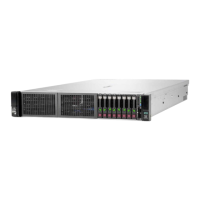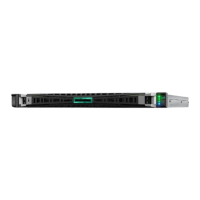◦ Normal—Only allocates PCIe resources to devices installed at boot time. PCIe hot-add is not
supported.
◦ Medium—Allocates additional PCIe resources for each PCIe root port, which might enable a
PCIe hot-add event to work without requiring a system reboot to enumerate the device.
◦ High—Allocates a maximum amount of PCIe resources to allow for the best chance of
supporting a PCIe hot-add event.
• Maximum PCI Express Speed—When Workload Profile is set to Custom, sets the maximum
speed at which the server allows PCI Express devices to operate.
◦ Per Port Control
◦ PCIe Generation 1.0
3. Save your settings.
Setting GPU Configurations
Procedure
1. From the System Utilities screen, select System Configuration > BIOS/Platform Configuration
(RBSU) > PCIe Device Configuration > GPU CFG Selection.
2. Select an option.
• 4:1—Maps 4 PCIe slots to each installed processor.
• 8:1—Maps all slots to a single processor.
3. Save your settings.
Selecting PCIe bifurcation options
Procedure
1. From the System Utilities screen, select System Configuration > BIOS/Platform Configuration
(RBSU) > PCIe Device Configuration > PCIe Bifurcation Options.
2. Select an option.
• Enabled—Splits a PCIe slot into two equal-width slots. Use this option for cards that support or
require bifurcation.
• Disabled—Does not bifurcate a PCIe slot.
3. Save your settings.
Configuring specific PCIe devices
Use the PCIe Device Configuration options to enable or disable, and select configuration settings for
embedded and added-in PCI devices. Disabling devices reallocates the resources (memory, I/O, and
ROM space and power) that are normally allocated to the device. By default, all devices are enabled.
120 Setting GPU Configurations

